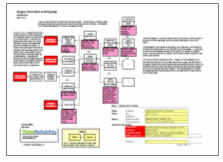Blood transfusions are fairly common, with 25 million blood component transfusions occurring per year. Blood transfusions are also very safe. The risk of health concerns from blood component transfusions is extremely low. Until recently, it was believed that all the concerns from transfused blood were being tested for and rooted out. However, a new case presented in the New England Journal of Medicine has presented a new concern.
A six-year-old boy in the Netherlands was receiving pooled platelets when he suffered from an allergic reaction. The staff was able to prevent potential death or serious injury with an immediate injection of adrenaline. As a follow-up, the staff tested the boy and ruled out many other potential causes. The lab tests and testimony from the boy’s mother confirmed an allergy to a peptide, which is a protein that is left in the blood after ingesting peanuts. The peptide, known as Ara h2, is resistant to digestion, as evidenced by studies that have found levels in the blood 24 hours after ingestion.
Because this case demonstrates a newly discovered phenomenon, evidence to support the causes is particularly important. Evidence supporting the placement of a cause related to a root cause analysis can be placed in a box directly below the cause box on a Cause Map. (To see the Cause Map, click on “Download PDF” above.) The allergy to the peanut peptide causing the allergic reaction and the peptides being present were verified by testing and interviews with the donors and the patient’s family.
 The immediate solution, to inject adrenaline to prevent the patient’s death from the allergic reaction, was taken immediately but does not do anything to solve the broader problem of potential allergens in the blood supply. One of the potential solutions is to screen the blood supply for dietary contributions, but considering the large amount of donors and recipients, this is considered to be prohibitively expensive and difficult. Because there is not a viable alternative blood transplant source, and blood transfusions are still needed by patients with allergies, it seems that the solution must be to figure out a way to remove the proteins, at least from blood transfusions going to people with allergies. However, another case, from 2003 resulted in a blood product recipient developing allergies when receiving a blood transfusion from a donor who had peanut allergies, so screening the blood supply prior to transfusing people with allergies may not be sufficient.
The immediate solution, to inject adrenaline to prevent the patient’s death from the allergic reaction, was taken immediately but does not do anything to solve the broader problem of potential allergens in the blood supply. One of the potential solutions is to screen the blood supply for dietary contributions, but considering the large amount of donors and recipients, this is considered to be prohibitively expensive and difficult. Because there is not a viable alternative blood transplant source, and blood transfusions are still needed by patients with allergies, it seems that the solution must be to figure out a way to remove the proteins, at least from blood transfusions going to people with allergies. However, another case, from 2003 resulted in a blood product recipient developing allergies when receiving a blood transfusion from a donor who had peanut allergies, so screening the blood supply prior to transfusing people with allergies may not be sufficient.



